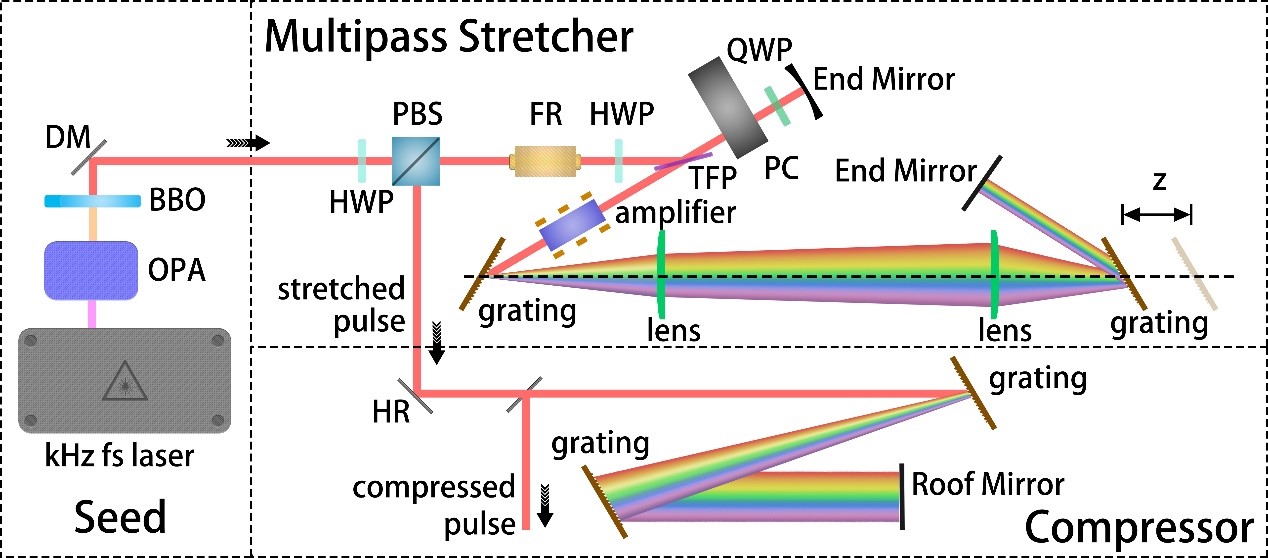Ultra-intense and ultra-short lasers can provide unprecedented experimental conditions and methods, which are playing important roles in plenty of cutting-edge research fields.
Many institutes and laboratories around the world are currently focusing and competing on the development of ultra-intense and ultra-short laser facilities, such as Extreme Light Infrastructure (ELI) facilities in Europe, Apollon 10 PW laser project in France, and SULF 10 PW laser project in China.
Chirped pulse amplification (CPA) is one of the main technology methods to achieve ultra-intense lasers. For a traditional chirped pulse amplifier, the flux of output pulse energy is difficult to reach more than 4J/cm2, which is limited by the narrowed chirped pulse width. While compared with short-pulse amplification, the applying of long pulse width will overcome the disadvantage and reduce the possibility of laser damage. C.P.Barty raised an exawatt-scale architecture called “Nexawatt” by using a 20-ns long duration chirped pulse.
Therefore, achieving a long-duration chirped pulse is a key technology to promote the development of ultra-intense lasers. As is well-known, traditional stretching methods are mainly based on the offner-type stretcher and Martinez-type stretcher. For these methods, however, it is not easy to achieve chirped pulses above 10 ns as large space and extremely large gratings with meter size are necessary for these stretching setups to achieve large chirp rate.
One recent study by a research team from State Key Laboratory of High Field Laser Physics, Shanghai Institute of Optics and Fine Mechanics of the Chinese Academy of Sciences (CAS), demonstrated a novel multipass stretcher, which combines the structures of a Martinez stretcher and a regenerative amplifier. The result was published in Optics Letters.
In this experiment, the multipass stretcher is a combination of a Martinez-type stretcher and a regenerative amplifier. The stretcher in this method is repeatedly used. Researchers injected the ultrafast laser seed into the multipass stretcher. By controlling the roundtrip of the pulses running in the cavity, chirped pulses with more than 10 ns even scaling to 30 ns pulse duration can be obtained. The stretching ratio can be changed without changing the layout. To compensate the diffraction loss, an Nd:Glass amplifier was inserted in the multipass stretcher. The laser pulses would be stretched and amplified simultaneously, and the pulse energy above millijoules can be achieved after stretching.
With this multipass structure, femtosecond ultrafast laser pulses can be stretched to as much as 10 ns. At the same time, the pulse duration can be adjusted without changing the layout. The stretching ratio is unattainable for traditional stretchers. Benefited by the advantage of the regenerative structure, the output pulses have an excellent beam quality with M2 of 1.1. In conclusion.
This novel multipass stretcher can achieve incredibly large stretching ratio and great beam quality, which is significant for high peak-power laser systems. With this stretcher, chirped pulses with long duration can be generated easily and can improve the output capacity to 10 kJ scale for a high-energy laser system, which can contribute enormously to the peak power of 100 PW or even higher.

Figure. Schematic of the stretching system.
Article website:
https://www.osapublishing.org/ol/abstract.cfm?uri=ol-44-8-1980&origin=search
Contact:
Mr. Cao Yong
General Administrative Office
Shanghai Institute of Optics and Fine Mechanics, CAS
Email: caoyong@siom.ac.cn